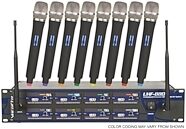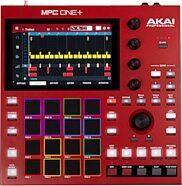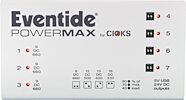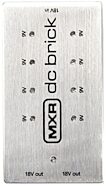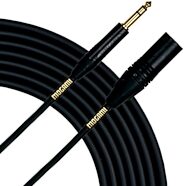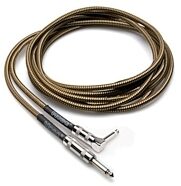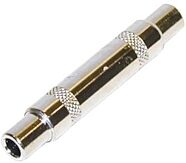Mark of the Unicorn (MOTU) 896 Crossplatform Firewire Audio Interface (Macintosh and Windows)
No longer available at zZounds


zZounds Gear Experts Say...
44.1, 48, 88.2, and 96kHz sample rates supported. Stereo AES/EBU input and output.
Overview
The 896 is a 96kHz firewire audio interface for Macintosh and Windows. It provides everything you need to make great recordings, all in a durable 2U rack mountable package.
The 896 is expandable. Should your needs grow in the future, simply add additional 896 or 828 interfaces for more I/O.
The 896 is the perfect companion for your laptop computer. With 8 built-in mic pre-amps with individually switchable phantom power and no-latency CueMix Plus monitoring, you don't need a mixer for portable recording.
Included with the 896 is the acclaimed AudioDesk workstation software for Macintosh. Of course, the 896 ships with Sound Manager, ASIO, GSIF, and WDM drivers for compatibility with your favorite software.
Features
Drivers for Mac & PC — for all popular Macintosh and Windows audio software (ASIO/WDM/Wave/Sound Manager drivers)
Expandable with additional MOTU Firewire based interfaces such as the MOTU 828.
100% compatible with all host-based effects processing in today's popular audio programs
44.1, 48, 88.2, and 96kHz sample rates supported
CueMix Plus zero-latency hardware patchthru system
Includes AudioDesk full-featured sample-accurate workstation software for MacOS with recording, editing, mixing, real-time 32-bit effects processing and sample-accurate sync
8 channels of 24-bit ADAT optical input/output
Sample-accurate digital transfers between ADAT digital tape decks and the computer via the ADAT sync port
Stereo AES/EBU input and output with built in sample… read more rate conversion
Word clock I/O for easy integration into a studio with many devices with digital I/O. Can slave to word clock at half-speed or double speed. Can send word clock at half speed when running at 88.2 or 96 kHz
Eight 24-bit analog inputs using balanced/unbalanced 1/4 in./XLR Neutrik combo connectors
8 mic pre-amps with switchable 48-volt phantom power on the front panel
Eight 24-bit analog outputs using balanced XLR connectors. Each output is individually switchable to +4 or -10
109dB dynamic range
Front panel volume control of monitor input level on main outs
Front panel headphone jack with independent volume control
Extensive multi-segment front panel metering for all I/O and clock modes. Software-configurable peak and clip hold times
Trim controls for all inputs on front panel
Front panel footswitch/punch jack
The MOTU 896 includes the double rack space I/O unit, a 15-ft. FireWire cable to connect the 896 to your computer, software drivers for both Mac OS and Windows, and AudioDesk, a complete Macintosh audio workstation software package.
The 896 is expandable. Additional 896 or 828 units can be combined to handle large studio projects. Consult the MOTU Firewire 2.0 driver press release for more information.
AudioDesk gives you all of the features you need to record, edit, mix, process and master an audio project in your Power Macintosh computer. It even includes MOTU's groundbreaking PureDSP time-stretching and pitch-shifting technology and dozens of real-time, 32-bit effects plug-ins.
Metering
These 10-segment level meters provide a range from -42dB to clip with two red "over" LEDs. One remains illuminated after clipping while the other remains active to provide feedback during further adjustment.
The second bank of meters can be programmed from the MOTU FireWire Audio console software to display one of the following 8-channel banks of I/O: analog output, ADAT input, or ADAT output. For example, you may want to routinely monitor analog output, but temporarily monitor the ADAT inputs during an optical transfer.
Metering/Clock Indicators
Main output meters — this is a dedicated pair of 10-segment meters for the main outs.
AES/EBU digital meters — these stereo meters can be programmed from the MOTU FireWire Audio Console software to display either AES/EBU input or output.
Indicate the system clock setting (44.1, 48, 88.2, or 96 kHz) and the sample rate conversion for the AES/EBU input or output, if any.
Front Panel Trims/Phantom Power
All eight analog inputs have individual input trim knobs, which provide a trim range of approximately 30dB for the LINE setting (on the rear panel) and approximately 40dB for the MIC setting (with some overlap between the two settings).
8 phantom power switches Provide 48-volt phantom power to each input.
Monitor Section
Main volume knob with toggle switch Controls the headphone out and, if the toggle switch is flipped up, the main outs.
Monitor level knob — controls the volume of any two analog or AES/EBU inputs being monitored on the main outs, if any.
Quarter-inch foot switch input Connects to any standard foot switch for hands-free punch-in and punch-out during recording.
AES/EBU Digital I/O
AES/EBU digital in/out provides digital I/O at any supported sample rate up to 96 kHz. Sample rate conversion is supplied on either input or output. The AES/EBU input can convert from any sample rate to the 896 system rate. For example, it can convert 44.1 kHz audio input to 96 kHz. The AES/EBU output can either double or halve the 896 system clock rate. For example, it can convert 96 kHz audio to 48 kHz. In addition, the AES/EBU OUT can resolve to the AES/EBU input while converting, with the input serving as a clock source only (not as an input source).
Main Outputs
These 2 extra XLR outputs can be connected directly to a set of powered monitors. A front panel volume knob is provided for convenient hands-on volume control. this control may be bypassed with the front panel toggle switch. The main outputs mirror the signal on outputs 1 and 2. In addition, they sum these signals with up to 2 channels of live input from a pair of inputs via the 896's no-latency monitoring bus. You may choose any 2 analog or AES/EBU inputs (via software) as the monitor inputs. A separate knob is provided on the front panel for convenient hands-on adjustment of the live input level, relative to the main mix.
Analog Outputs
Eight analog outputs on XLR connectors. Each output is equipped with 24-bit 128x "enhanced multi-bit" D/A converters and includes its own switch for either +4 or -10dB operation.
IEC Power
The 896 has an internal power supply with a convenient external switch for either 115V or 230V operation.
Word Clock
Allows the 896 to resolve word clock via a standard synchronizer such as the MOTU MIDI Timepiece AV. This enables you to lock to SMPTE time code, blackburst, video or other external clock sources. Can slave to word clock at half-speed or double speed. Can send word clock at half speed when running at 88.2 or 96 kHz.
ADAT Lightpipe Digital I/O
These standard ADAT optical jacks can operate at 44.1 or 48 kHz, or they can be turned off (to conserve FireWire bus bandwidth). They are automatically disabled when the 896 is operated at 88.2 or 96 kHz.
ADAT Sync & Firewire I/O
9-pin ADAT sync input allows sample-accurate digital transfers with ADATs or any other device that supports ADAT SYNC. This allows you to make digital transfers between your computer and other optical devices without your tracks drifting by even one sample.
Two standard 1394 FireWire connectors can be used to connect the 896 to the FireWire port on any computer via a standard FireWire cable. Additional MOTU FireWire audio interfaces can be connected to the second FireWire jack. Up to 4 interfaces can be daisy-chained (connected one to another) on a single FireWire bus (without a hub), providing 72 channels of I/O at 44.1 or 48 kHz. At high sample rates (88.2 or 96 kHz), the ADAT optical channels are disabled and 2 or 3 interfaces can supply analog and AES/EBU I/O for 20 to 30 channels of I/O, respectively (depending on system performance). A MOTU 828 FireWire audio interface can also be connected to the second FireWire jack of a MOTU 896. In addition, multiple 828s can be mixed and matched with multiple 896s using standard FireWire hubs.
Analog Inputs
Each input is equipped with a 24-bit 64x oversampling A/D converter, built-in preamp, front-panel trim knob, front-panel 48 volt phantom power switch and a rear-panel 3-way input level switch with 3 settings: MIC, LINE and +4/FIXED. The MIC and LINE settings provide front-panel trim, while the +4/FIXED setting bypasses the trim circuit for unattenuated signals up to approximately +18dBu. Together, the MIC and LINE settings provide a trim range of approximately 55dB with some overlap. The LINE setting can accommodate a -10 or +4 input signal. The MIC setting can be used for microphones or unamplified instrument pickups (guitars, etc.)
CueMix Plus — No Latency Monitoring
The 896 gives you the ability to select a mono or stereo input via software and mix it with the main outputs inside the 896 to create a no latency monitor mix. Because the mix does not have to travel back to the computer, the result is delay-less patch-thru. This mix is sent out the main outs and headphones. You can adjust the patch thru volume relative to the main mix with the convenient front panel monitor level knob. read less
The 896 is expandable. Should your needs grow in the future, simply add additional 896 or 828 interfaces for more I/O.
The 896 is the perfect companion for your laptop computer. With 8 built-in mic pre-amps with individually switchable phantom power and no-latency CueMix Plus monitoring, you don't need a mixer for portable recording.
Included with the 896 is the acclaimed AudioDesk workstation software for Macintosh. Of course, the 896 ships with Sound Manager, ASIO, GSIF, and WDM drivers for compatibility with your favorite software.
Features
Drivers for Mac & PC — for all popular Macintosh and Windows audio software (ASIO/WDM/Wave/Sound Manager drivers)
Expandable with additional MOTU Firewire based interfaces such as the MOTU 828.
100% compatible with all host-based effects processing in today's popular audio programs
44.1, 48, 88.2, and 96kHz sample rates supported
CueMix Plus zero-latency hardware patchthru system
Includes AudioDesk full-featured sample-accurate workstation software for MacOS with recording, editing, mixing, real-time 32-bit effects processing and sample-accurate sync
8 channels of 24-bit ADAT optical input/output
Sample-accurate digital transfers between ADAT digital tape decks and the computer via the ADAT sync port
Stereo AES/EBU input and output with built in sample… read more rate conversion
Word clock I/O for easy integration into a studio with many devices with digital I/O. Can slave to word clock at half-speed or double speed. Can send word clock at half speed when running at 88.2 or 96 kHz
Eight 24-bit analog inputs using balanced/unbalanced 1/4 in./XLR Neutrik combo connectors
8 mic pre-amps with switchable 48-volt phantom power on the front panel
Eight 24-bit analog outputs using balanced XLR connectors. Each output is individually switchable to +4 or -10
109dB dynamic range
Front panel volume control of monitor input level on main outs
Front panel headphone jack with independent volume control
Extensive multi-segment front panel metering for all I/O and clock modes. Software-configurable peak and clip hold times
Trim controls for all inputs on front panel
Front panel footswitch/punch jack
The MOTU 896 includes the double rack space I/O unit, a 15-ft. FireWire cable to connect the 896 to your computer, software drivers for both Mac OS and Windows, and AudioDesk, a complete Macintosh audio workstation software package.
The 896 is expandable. Additional 896 or 828 units can be combined to handle large studio projects. Consult the MOTU Firewire 2.0 driver press release for more information.
AudioDesk gives you all of the features you need to record, edit, mix, process and master an audio project in your Power Macintosh computer. It even includes MOTU's groundbreaking PureDSP time-stretching and pitch-shifting technology and dozens of real-time, 32-bit effects plug-ins.
Metering
These 10-segment level meters provide a range from -42dB to clip with two red "over" LEDs. One remains illuminated after clipping while the other remains active to provide feedback during further adjustment.
The second bank of meters can be programmed from the MOTU FireWire Audio console software to display one of the following 8-channel banks of I/O: analog output, ADAT input, or ADAT output. For example, you may want to routinely monitor analog output, but temporarily monitor the ADAT inputs during an optical transfer.
Metering/Clock Indicators
Main output meters — this is a dedicated pair of 10-segment meters for the main outs.
AES/EBU digital meters — these stereo meters can be programmed from the MOTU FireWire Audio Console software to display either AES/EBU input or output.
Indicate the system clock setting (44.1, 48, 88.2, or 96 kHz) and the sample rate conversion for the AES/EBU input or output, if any.
Front Panel Trims/Phantom Power
All eight analog inputs have individual input trim knobs, which provide a trim range of approximately 30dB for the LINE setting (on the rear panel) and approximately 40dB for the MIC setting (with some overlap between the two settings).
8 phantom power switches Provide 48-volt phantom power to each input.
Monitor Section
Main volume knob with toggle switch Controls the headphone out and, if the toggle switch is flipped up, the main outs.
Monitor level knob — controls the volume of any two analog or AES/EBU inputs being monitored on the main outs, if any.
Quarter-inch foot switch input Connects to any standard foot switch for hands-free punch-in and punch-out during recording.
AES/EBU Digital I/O
AES/EBU digital in/out provides digital I/O at any supported sample rate up to 96 kHz. Sample rate conversion is supplied on either input or output. The AES/EBU input can convert from any sample rate to the 896 system rate. For example, it can convert 44.1 kHz audio input to 96 kHz. The AES/EBU output can either double or halve the 896 system clock rate. For example, it can convert 96 kHz audio to 48 kHz. In addition, the AES/EBU OUT can resolve to the AES/EBU input while converting, with the input serving as a clock source only (not as an input source).
Main Outputs
These 2 extra XLR outputs can be connected directly to a set of powered monitors. A front panel volume knob is provided for convenient hands-on volume control. this control may be bypassed with the front panel toggle switch. The main outputs mirror the signal on outputs 1 and 2. In addition, they sum these signals with up to 2 channels of live input from a pair of inputs via the 896's no-latency monitoring bus. You may choose any 2 analog or AES/EBU inputs (via software) as the monitor inputs. A separate knob is provided on the front panel for convenient hands-on adjustment of the live input level, relative to the main mix.
Analog Outputs
Eight analog outputs on XLR connectors. Each output is equipped with 24-bit 128x "enhanced multi-bit" D/A converters and includes its own switch for either +4 or -10dB operation.
IEC Power
The 896 has an internal power supply with a convenient external switch for either 115V or 230V operation.
Word Clock
Allows the 896 to resolve word clock via a standard synchronizer such as the MOTU MIDI Timepiece AV. This enables you to lock to SMPTE time code, blackburst, video or other external clock sources. Can slave to word clock at half-speed or double speed. Can send word clock at half speed when running at 88.2 or 96 kHz.
ADAT Lightpipe Digital I/O
These standard ADAT optical jacks can operate at 44.1 or 48 kHz, or they can be turned off (to conserve FireWire bus bandwidth). They are automatically disabled when the 896 is operated at 88.2 or 96 kHz.
ADAT Sync & Firewire I/O
9-pin ADAT sync input allows sample-accurate digital transfers with ADATs or any other device that supports ADAT SYNC. This allows you to make digital transfers between your computer and other optical devices without your tracks drifting by even one sample.
Two standard 1394 FireWire connectors can be used to connect the 896 to the FireWire port on any computer via a standard FireWire cable. Additional MOTU FireWire audio interfaces can be connected to the second FireWire jack. Up to 4 interfaces can be daisy-chained (connected one to another) on a single FireWire bus (without a hub), providing 72 channels of I/O at 44.1 or 48 kHz. At high sample rates (88.2 or 96 kHz), the ADAT optical channels are disabled and 2 or 3 interfaces can supply analog and AES/EBU I/O for 20 to 30 channels of I/O, respectively (depending on system performance). A MOTU 828 FireWire audio interface can also be connected to the second FireWire jack of a MOTU 896. In addition, multiple 828s can be mixed and matched with multiple 896s using standard FireWire hubs.
Analog Inputs
Each input is equipped with a 24-bit 64x oversampling A/D converter, built-in preamp, front-panel trim knob, front-panel 48 volt phantom power switch and a rear-panel 3-way input level switch with 3 settings: MIC, LINE and +4/FIXED. The MIC and LINE settings provide front-panel trim, while the +4/FIXED setting bypasses the trim circuit for unattenuated signals up to approximately +18dBu. Together, the MIC and LINE settings provide a trim range of approximately 55dB with some overlap. The LINE setting can accommodate a -10 or +4 input signal. The MIC setting can be used for microphones or unamplified instrument pickups (guitars, etc.)
CueMix Plus — No Latency Monitoring
The 896 gives you the ability to select a mono or stereo input via software and mix it with the main outputs inside the 896 to create a no latency monitor mix. Because the mix does not have to travel back to the computer, the result is delay-less patch-thru. This mix is sent out the main outs and headphones. You can adjust the patch thru volume relative to the main mix with the convenient front panel monitor level knob. read less
Documents and Manuals
For support or warranty questions, please contact the manufacturer:
Phone: 617-576-2760
Web: https://motu.com/techsupport
Phone: 617-576-2760
Web: https://motu.com/techsupport
No longer available at zZounds
In most cases, a product is unavailable because it has been discontinued by the manufacturer
This is a carousel with product cards. Use the previous and next buttons to navigate.



